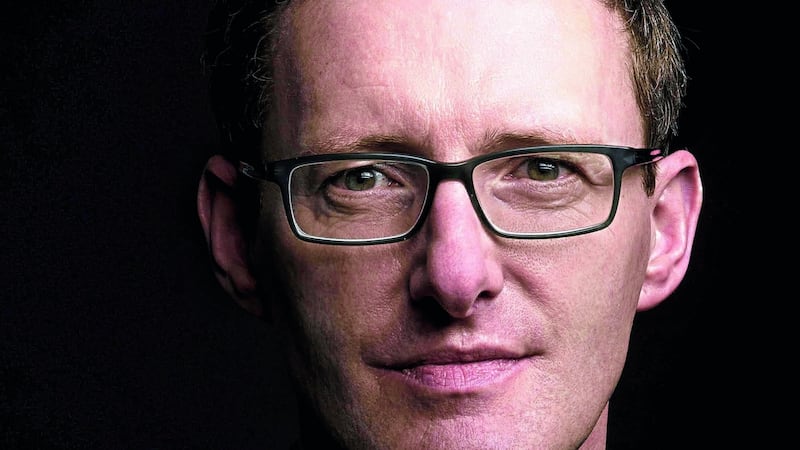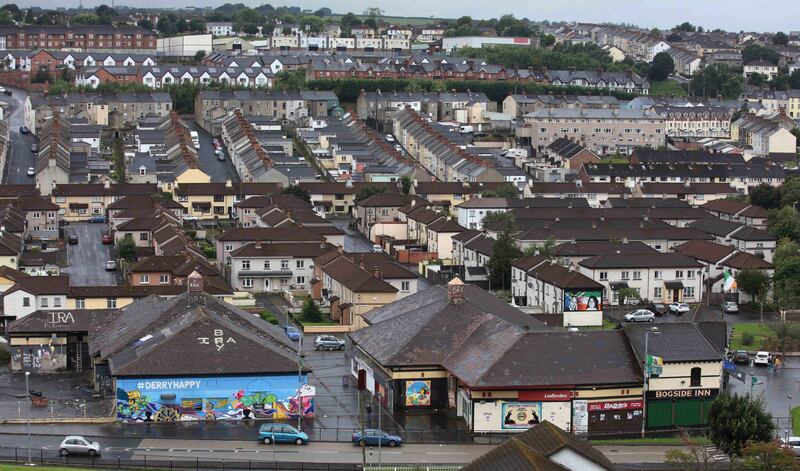Earlier this summer, on a visit to my home place of Derry, I went for a walk on the old city walls, and then along the Foyle to my parents’ house in the northern suburbs. My usual beat, taking in familiar scenes and sights, and in the process communing with a place I continue to think of as home, though by now I’ve lived away much longer than I ever lived in Derry.
I was looking as I walked. In Derry, if you know where to look and how, you can give a good shake to the notion that history happens in a straight line, that what was is now past, that a whole heap of other happenings has buried older history deep in the soil, deep in time. Because in Derry, the history of the place in all its accretions lies not buried but open to the light. You have to, yes, shake away any linear notions you might have, and acknowledge that history is alive and breathing all around you. If, as I say, you know where to look and how.
A compelling dramatisation of this sense was laid on in Derry a few years ago, when an archaeological dig took place in the car park that now envelops the former garden of the Bishop’s palace adjoining the city walls. The skeleton of a child of eight or 10 years old, several skulls, musket shot, all dating from the time of the 17th-century siege of the city. The child’s milk teeth were still present, there were coins and pottery nearby: and suddenly I had this small person’s life in my mind’s eye, surrounded by adults doing their best for her at a time of violence – only, their best had not been good enough. Milk teeth. It could be any family, it could be the here and the now.
You can complete a circuit of the city walls, seven gates and five bastions, in 40 minutes or so; while the walk north along the river – another 40 minutes or so for me today – offers wide views of sky, river, blue Donegal hills. You get a sense of Derry’s superlative natural setting – and an insight too into specificity of place and the intrinsic drama of this city. Stand up on the high ramparts and look around, stand on the riverbank and take in the scene: and you can understand how topography begets history, and how history generates a particular built environment. And something else, something current and local: a sense of how policies and decisions made elsewhere have preyed on this city for a century, starved it, blighted its daily life, toyed with its future.
RM Block
A fine, dry day – and standing up on the double bastion, I see the valley floor of the Bogside at my feet, red Victorian houses climbing the farther hill, the invisible Border clipping the suburbs, Inishowen just beyond. Home ground, intimately known and loved. My grandparents are buried up there on the hill; my father was born down there on Blucher Street (Wellington, Nelson, Blucher, Waterloo: many of the streets around the Bogside invoke Napoleonic-era names); my parents had their first house over there in Rosemount; I went to school there, where the green cupola of the old St Columb’s College peeps through the trees.
Layered private meaning – woven with public history, because there’s Free Derry Corner also just below me, and the streets and yards where the Bloody Sunday massacre took place; and the courthouse just behind me, its outsize scales of justice on the pediment and the tower of the Guildhall – more green copper – with its sheets of glowing stained glass detailing the building of colonial Londonderry. The Apprentice Boys, all banners and flutes, parade on this stretch of the city walls every August and December: and these marches pass smoothly for the most part, though a little trouble tends to smoke later in the day. But even here I can appreciate Derry’s distinctiveness: the Apprentice Boys and local residents long ago came to a cordial meeting of minds, so that such flaring troubles have been stripped of much of their heat and fire. The anthropologists call this a cultural landscape – meaning a political landscape, the vibrations of politics in every brick course, every footpath.
The walls of Derry are today invariably thronged with North American, Asian and European tourists. There’s much for them to see, a whole political and cultural education if they’re up for it, and all of it compressed into this small city centre. I wonder what else they notice, beyond what the guide books and apps point out. Because when I come to Derry these days, I see dereliction, I hear stories of poverty, I feel an overwhelming sense of fragility. Buddleia sprouts from the bricks of 19th-century town houses and slates slip on neglected roofs; city-centre spaces where buildings once stood, left empty for years.
Derry invariably tops the list when it comes to UK indices of social deprivation. In the commercial life of the place, whole shopping streets are given over to empty premises and charity shops – and such development as does occur in Derry is characteristically piecemeal, and lacking in ambition: any old rubbish, I often think, will be greenlit by the planners. The tourist literature won’t draw your attention to such unglamorous detail, but there’s no difficulty in detecting the tremors in a city teetering on the edge of – something, something else, some other as-yet unspecified future.

I was born in Derry in 1970 and for the whole of my life, this has been a city on edge, and on the edge. On the furthest edge of the United Kingdom and of Northern Ireland, set against a Border that was laid down in 1920 without regard to the social and economic realities on the ground. The new Protestant-unionist Northern Ireland wanted its Londonderry, its city heavy with symbolism, its Jerusalem, and Derry was duly lopped from its Donegal hinterland – and left to rot. Transport connections were downgraded, economic investment was channelled systematically towards Belfast and the east of Northern Ireland – and nationalist Derry had no function in that new polity.
During the Troubles, the city burned but, while the Troubles ended in Derry years before they ended elsewhere, the peace dividend never meaningfully arrived. Today, Derry is more economically disadvantaged than it has ever been, more poor, more marginal. It is also more distinctively itself: a “whole and rain-domed universe,” as the poet Colette Bryce has it; “Monaco without the money,” wrote the late broadcaster Gerry Anderson. A world unto itself: Derry Girls showed the city’s exuberance, its anarchic humour – and its underlying sadness and its loneliness.
I leave the city walls and turn north along the Foyle, which shines today in the sun, and I see the buildings of Magee College – Ulster University’s reluctant presence in Derry – ranged across the hillside. The attitude of the university towards Magee is a long-festering public scandal: and one that speaks to the poisoned character of the North itself. Magee has been on the receiving end of neglect and overt political hostility ever since the 1960s, when Northern Ireland’s second university was sited, not here at Derry’s existing university college but in unionist-dominated Coleraine. Today, Ulster University has to maintain a presence in Derry, for political reasons, but it doesn’t want to be here. The university has constructed a ruinously expensive new campus in Belfast – while Magee is maintained in stunted form. Repeatedly, promises are made to expand student numbers, and repeatedly these promises are broken. This higher education drama reeks of toxicity, with the city the victim of political forces beyond its ability to control.

As I walk, I replay a conversation in Dublin a few weeks previously, at the Royal Irish Academy, which has commissioned a report itemising the manifold benefits that would flow from the establishment of an independent university in Derry. Stormont and Northern Ireland’s political parties ignored the report and its findings. A new university: this was the call during the 1960s civil-rights era, and it remains unmet today. That Dublin conversation detailed the recent establishment of a medical school at Magee: an excellent development – but perhaps, I think, I ought to have chipped in an observation that the school was developed years and years late, and in the teeth of bitter political opposition from unionist politicians in Belfast. But now I recall that the Irish Government has recently invested €45 million in Magee: a straw in the wind – a portal into the future. Milk teeth.

Because this is Northern Ireland’s terminal phase. This place never made any ethical or economic sense – and Derry is the apotheosis of that wider failure. A century ago, the city was locked into a senseless connection with Belfast – and today, it is being sucked dry by this same connection: by the overwhelming Belfast-centrism of Northern Ireland’s economic and political life. When Northern Ireland is wound up, I hope to see natural patterns of society and economics revive, and a century of waste in Derry swept away. I often dream as I walk – I’m doing it again today: I imagine new university buildings, the campus spilling out from its old hillside grounds, reaching towards the city centre, regenerating neighbourhoods, bringing people to live, work, study in central Derry. The city buoyed up, able at last to reach its potential, to acknowledge the past – and let it go.
And of course, this is no dream, but the future already on the way.
Neil Hegarty is a writer from Derry whose novels include The Jewel and Inch Levels. He is co-editor with Nora Hickey M’Sichili of the essay collection Impermanence
- Sign up for push alerts and have the best news, analysis and comment delivered directly to your phone
- Join The Irish Times on WhatsApp and stay up to date
- Listen to our Inside Politics podcast for the best political chat and analysis


















